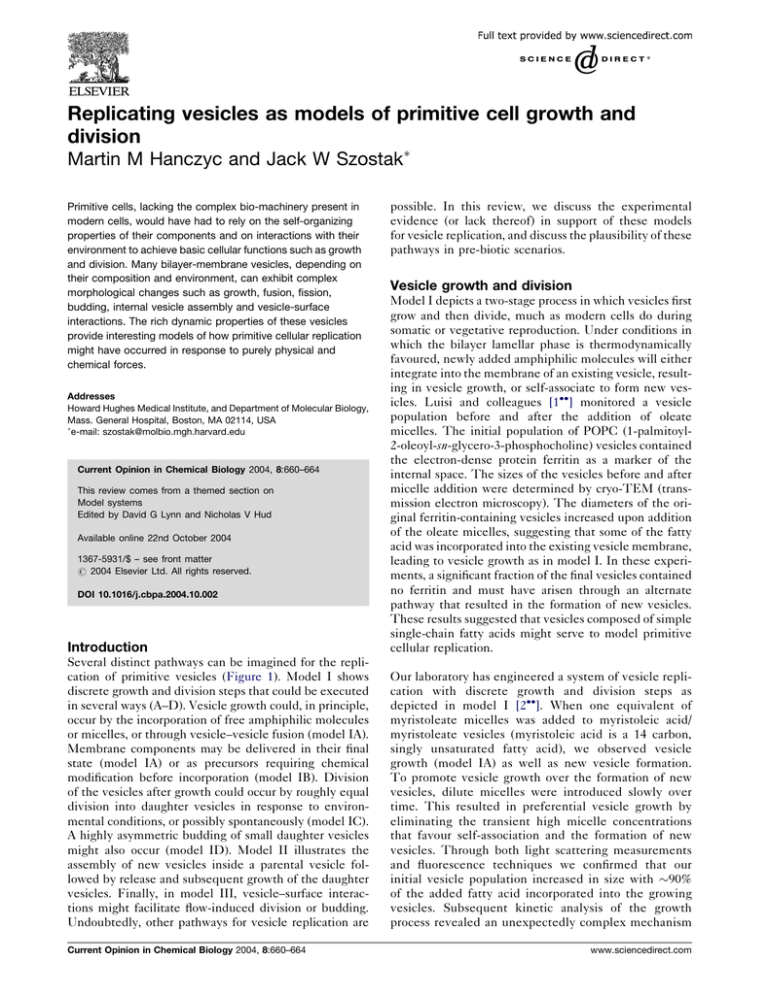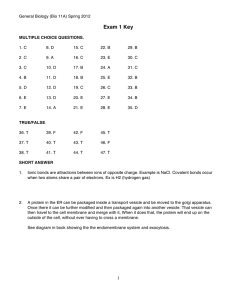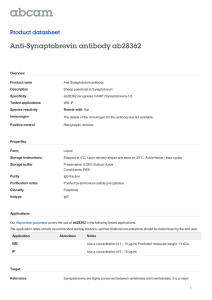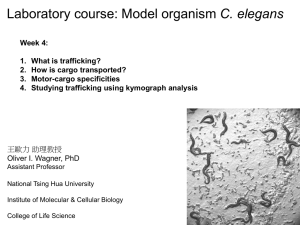
Replicating vesicles as models of primitive cell growth and
division
Martin M Hanczyc and Jack W Szostak
Primitive cells, lacking the complex bio-machinery present in
modern cells, would have had to rely on the self-organizing
properties of their components and on interactions with their
environment to achieve basic cellular functions such as growth
and division. Many bilayer-membrane vesicles, depending on
their composition and environment, can exhibit complex
morphological changes such as growth, fusion, fission,
budding, internal vesicle assembly and vesicle-surface
interactions. The rich dynamic properties of these vesicles
provide interesting models of how primitive cellular replication
might have occurred in response to purely physical and
chemical forces.
possible. In this review, we discuss the experimental
evidence (or lack thereof) in support of these models
for vesicle replication, and discuss the plausibility of these
pathways in pre-biotic scenarios.
Vesicle growth and division
Introduction
Model I depicts a two-stage process in which vesicles first
grow and then divide, much as modern cells do during
somatic or vegetative reproduction. Under conditions in
which the bilayer lamellar phase is thermodynamically
favoured, newly added amphiphilic molecules will either
integrate into the membrane of an existing vesicle, resulting in vesicle growth, or self-associate to form new vesicles. Luisi and colleagues [1] monitored a vesicle
population before and after the addition of oleate
micelles. The initial population of POPC (1-palmitoyl2-oleoyl-sn-glycero-3-phosphocholine) vesicles contained
the electron-dense protein ferritin as a marker of the
internal space. The sizes of the vesicles before and after
micelle addition were determined by cryo-TEM (transmission electron microscopy). The diameters of the original ferritin-containing vesicles increased upon addition
of the oleate micelles, suggesting that some of the fatty
acid was incorporated into the existing vesicle membrane,
leading to vesicle growth as in model I. In these experiments, a significant fraction of the final vesicles contained
no ferritin and must have arisen through an alternate
pathway that resulted in the formation of new vesicles.
These results suggested that vesicles composed of simple
single-chain fatty acids might serve to model primitive
cellular replication.
Several distinct pathways can be imagined for the replication of primitive vesicles (Figure 1). Model I shows
discrete growth and division steps that could be executed
in several ways (A–D). Vesicle growth could, in principle,
occur by the incorporation of free amphiphilic molecules
or micelles, or through vesicle–vesicle fusion (model IA).
Membrane components may be delivered in their final
state (model IA) or as precursors requiring chemical
modification before incorporation (model IB). Division
of the vesicles after growth could occur by roughly equal
division into daughter vesicles in response to environmental conditions, or possibly spontaneously (model IC).
A highly asymmetric budding of small daughter vesicles
might also occur (model ID). Model II illustrates the
assembly of new vesicles inside a parental vesicle followed by release and subsequent growth of the daughter
vesicles. Finally, in model III, vesicle–surface interactions might facilitate flow-induced division or budding.
Undoubtedly, other pathways for vesicle replication are
Our laboratory has engineered a system of vesicle replication with discrete growth and division steps as
depicted in model I [2]. When one equivalent of
myristoleate micelles was added to myristoleic acid/
myristoleate vesicles (myristoleic acid is a 14 carbon,
singly unsaturated fatty acid), we observed vesicle
growth (model IA) as well as new vesicle formation.
To promote vesicle growth over the formation of new
vesicles, dilute micelles were introduced slowly over
time. This resulted in preferential vesicle growth by
eliminating the transient high micelle concentrations
that favour self-association and the formation of new
vesicles. Through both light scattering measurements
and fluorescence techniques we confirmed that our
initial vesicle population increased in size with 90%
of the added fatty acid incorporated into the growing
vesicles. Subsequent kinetic analysis of the growth
process revealed an unexpectedly complex mechanism
Addresses
Howard Hughes Medical Institute, and Department of Molecular Biology,
Mass. General Hospital, Boston, MA 02114, USA
e-mail: szostak@molbio.mgh.harvard.edu
Current Opinion in Chemical Biology 2004, 8:660–664
This review comes from a themed section on
Model systems
Edited by David G Lynn and Nicholas V Hud
Available online 22nd October 2004
1367-5931/$ – see front matter
# 2004 Elsevier Ltd. All rights reserved.
DOI 10.1016/j.cbpa.2004.10.002
Current Opinion in Chemical Biology 2004, 8:660–664
www.sciencedirect.com
Replicating vesicles as models of primitive cell growth and division Hanczyc and Szostak 661
Figure 1
C
A
I
B
X
X
D
II
III
Current Opinion in Chemical Biology
Models of vesicle replication. I: Vesicle replication occurs through discrete steps of vesicle growth and division. (A) Growth can occur although
the incorporation of additional membrane components in the forms of free amphiphiles and micelles or through vesicle-vesicle fusion.
(B) Alternatively, vesicle growth can occur although the introduction of precursors that will form additional membrane components upon
chemical modification. (C) Division by vesicle fission can produce roughly equivalent daughter vesicle or (D) division can occur by asymmetric
budding. II: New vesicles are assembled within a parent vesicle. Daughter vesicles are then released. III: A surface support may assist
flow-induced vesicle growth and division.
involving fast and slow growth phases [3]. Fast growth is
limited to an increase of 40% in vesicle surface area,
possibly from the rapid formation of a coat of micelles
around pre-formed vesicles, followed by incorporation
of the micellar material into the vesicle membrane. The
slow growth phase seems to result from the interaction
of micelles to form larger aggregates, which can slowly
exchange into the vesicle membrane or can form new
vesicles. These kinetic experiments show that the rapid
addition of limited amounts of new material can lead to
efficient vesicle growth.
The rapid exchange of single-chain amphiphiles between
vesicles allows vesicle growth to occur by competition
between vesicles [4]. This pathway for vesicle growth is
based on the fact that osmotically swollen vesicles are in a
high energy state relative to relaxed (isotonic) vesicles.
The overall energy of a mixture of swollen and relaxed
vesicles can therefore be minimized by the transfer of
membrane components from the relaxed vesicles, which
shrink, to the swollen vesicles, which grow. This pathway
is particularly attractive from a pre-biotic perspective,
because the osmotically driven vesicle growth could
result from the internal replication of a nucleic acid
genome. Furthermore, faster replication of the internal
genetic material could translate directly into faster membrane growth, through the mediation of the osmotic
pressure generated by the counter-ions associated with
a charged genetic polymer such as RNA.
www.sciencedirect.com
Growth by vesicle–vesicle fusion (model IA) has the
advantage that it brings both new encapsulated material
and new membrane components to a growing vesicle.
Content fusion could replenish encapsulated materials
such as impermeable substrates, mineral grains, or
enzymes in growing vesicles. Vesicle growth by micelle
addition to fatty acid vesicles described above [2] may
be dependent upon the rapid exchange of single-chain
amphiphiles. By contrast, growth by vesicle fusion is
independent of this rapid exchange and thus allows for
the growth of vesicles composed of more complex amphiphiles such as phospholipids. The mixing of membrane
components following fusion is shown in Figure 2c–e [5].
Although the mechanism of fusion of phospholipid vesicles has received a great deal of attention because of its
biological importance (e.g. see [6]), fatty acid vesicle
fusion has not been explored. In biological systems,
fusion events are often triggered by a local increase in
Ca2+ concentration, although a complex set of protein–
protein and protein–membrane interactions also play
essential roles. However, fatty acid vesicles are very
sensitive to the presence of divalent cations. In the
presence of Ca2+, fatty acids aggregate and precipitate
or crystallize, suggesting that Ca2+-triggered fusion of
fatty acid vesicles may be problematic. Significantly, it
has been shown that vesicles made from a mixture of fatty
acids and their glycerol monoesters can withstand low
mM levels of Ca2+ [7]. It will be interesting to see if
vesicle–vesicle fusion events can be detected in such
Current Opinion in Chemical Biology 2004, 8:660–664
662 Model systems
Figure 2
The dynamic morphology of giant vesicles. (a,b) Giant phospholipid vesicles were labeled with two different domain-specific dyes.
A fission sequence triggered by heating the vesicles was captured by two-photon microscopy [9]. Scale bar, 5 microns. (c–e) Panels
taken from a video show the fusion of two charged phospholipid vesicles. The green fluorescence of the larger vesicle becomes quenched
as the red dye from the smaller vesicle mixes within the fused membranes [5]. Scale bar, 10 microns. (f–i) Panels show alumino-silicate
spheres by Nomarski optics (f,h) encapsulated within large dye-labeled myristoleate/myristoleic acid vesicles (g,i). Only the large vesicles
containing the spheres become packed full of smaller vesicles presumably due to surface catalyzed vesicle assembly within the giant vesicles. Scale
bar, 5 microns. Parts (a,b) reproduced from [9] with permission. Q Nature 2003 (http://www.nature.com/). Part (c–e) reproduced from [5] with
permission. Q 2003 Biophysical Journal.
systems. For primitive cells, even rare fusion events could
have been important in allowing recombination between
varying genotypes to occur. The origins of sex may thus
trace back to environmentally triggered vesicle fusion
events and the attendant mixing of encapsulated genetic
molecules.
Just as there are many possible pathways for vesicle
growth in model I, there are many potential mechanisms
for vesicle division. When Luisi and colleagues [1]
demonstrated the growth of ferritin-labeled vesicles, they
also saw a few very small vesicles containing ferritin that
may have been produced through spontaneous vesicle
fission (model IC). It is possible that these small vesicles
result from some instability of rapidly growing vesicles,
but this approach to spontaneous division needs more
study. To obtain more efficient and reproducible vesicle
Current Opinion in Chemical Biology 2004, 8:660–664
division, we extruded grown vesicles through small pores,
so that the extruded vesicles have the same diameter as
the initial population [2]. By monitoring a fluorescent
dye that was encapsulated in the initial vesicles, we were
able to show that all of the dye remained encapsulated
during growth and only a little more than expected was
lost during the division step due to the geometrical
constraint of division with constant surface area. The
growth and division cycle was completed five consecutive
times and presumably could be repeated indefinitely.
This simple system serves as a proof of principle that
primitive cellular replication could have occurred through
purely physico-chemical forces. Fluid flow through porous rocks near hydrothermal vents has been proposed as a
possible natural setting in which vesicle division by
extrusion might take place [8]. Experimental tests of this
idea are important, because it is far from clear that there
www.sciencedirect.com
Replicating vesicles as models of primitive cell growth and division Hanczyc and Szostak 663
would be sufficient fluid flow through small channels in
fractured rock to lead to significant vesicle division.
Division by budding (model ID) has been observed and
studied in giant vesicles composed of phospholipids and
other amphiphiles for many years [9,10–12]. A variety of
shape changes including budding can result from osmotically induced surface to volume changes, and thermally
induced changes in relative leaflet area. Several recent
papers illustrate new approaches to vesicle division by
budding.
Takakura and Sugawara [13] described the generation of
unusual myelin-like giant multi-lamellar vesicles, which
exhibit budding upon electrolyte addition. These giant
vesicles exhibited changes in morphology including both
growth and division by budding, upon addition of a lipid
precursor that hydrolyzes to generate both an amphiphile
and an electrolyte (model IB,D). This system requires the
presence of a membrane-incorporated catalyst of the
hydrolysis reaction, and this catalyst would have to be
replenished to allow for continued cycles of growth and
division. It will be interesting to see if the multi-lamellarity of these vesicles can be maintained over many
cycles of growth and division.
A new approach to the induction of budding makes use of
the spontaneous separation of certain lipid mixtures into
distinct phases. There is significant energy associated
with the phase boundaries, and minimization of this
energy can lead to budding and complete division. Giant
vesicles made with sphingomyelin, dioleoyl-phosphatidylcholine (DOPC) and cholesterol form discrete
domains with two distinct compositions that can be
labeled with different dyes [9] (Figure 2a,b). When
the temperature is raised, the domains increase in curvature, thus decreasing the length of their common boundary, until complete separation is achieved. Of course, the
daughter vesicles differ in composition from the parental
vesicle, and selective uptake of new lipid or re-equilibration of the lipid composition would have to occur to
enable repeated cycles of budding.
Budding can also result from the induction of bilayer
asymmetry. By loading one leaflet with components that
cannot flip to the other leaflet, the membrane may acquire
an intrinsic curvature that favours budding. Giant phosphatidylcholine/sphingomyelin vesicles have been
induced to bud by the asymmetrical sphingomyelinasecatalyzed generation of ceramide in the inner leaflet [10].
Vesicle fission and budding (model IC,D) can also be
achieved through the introduction of surfactants [11] and
through the action of enzymes such as phospholipase [12].
Internal production of vesicles
Model II illustrates a different approach to vesicle replication involving the internal synthesis of new vesicles.
www.sciencedirect.com
Wick, Walde and Luisi [14] observed the formation of
new vesicles inside a giant vesicle microscopically when
new amphiphiles were enzymatically synthesized inside
the vesicle. More recently, Takakura et al. have devised a
chemical system in which new amphiphiles are synthesized inside a giant vesicle [15]. In both cases, these new
vesicles were sometimes released from the original vesicle without rupture. The mechanism by which a vesicle
can pass through the membrane of a giant vesicle (sometimes referred to as ‘birthing’) is unclear.
An alternative approach to the enzymatic formation of
new internal vesicles involves the effects of encapsulated
mineral surfaces (model II). We have shown that a dispersion of montmorillonite clay in buffer can accelerate
the assembly of vesicles from fatty acid micelles [2].
When the vesicles form, some of the clay becomes
encapsulated in large vesicles, which in turn become
packed full of smaller vesicles (Figure 2f–i). This striking
effect is probably due to some of the added fatty acid
crossing the membrane, interacting with the surface of
the encapsulated clay, and forming new vesicles that are
then trapped inside the original vesicle. Repeated cycles
of internal vesicle synthesis, release and growth would
require some means by which clay particles could be
introduced into newly formed vesicles. While this could
potentially occur through vesicle–vesicle fusion, a more
interesting possibility would be internal mineral synthesis
by precipitation from a super-saturated solution of silicates, perhaps facilitated by some aspect of the internal
vesicle environment.
Surface-mediated vesicle replication
An intriguing but still hypothetical scheme for vesicle
replication invokes a role for fluid flow past surfaceattached vesicles, as shown in model III. Surface-attached
vesicles would grow through the uptake of additional
membrane components, eventually becoming unstable
to the shear gradient leading to the budding off of
daughter vesicles. Vesicles can be anchored to a surface
by either a specific integral membrane-bound linkage or
through adsorption. For example, vesicles may be tethered to an avidin-coated surface via biotinylated phospholipids [16]. Vesicles adsorbed to a surface have been
shown to fuse with additional vesicles introduced in fluid
flowing over the surface [17]. Giant fatty acid vesicles
have also been observed to assemble by the fusion of
smaller vesicles in regions of a glass surface coated by
hydrocarbons [18]. Microfluidic devices in which fluid
flow can be precisely controlled may well prove ideal for
the study of vesicle deformations in a flow-field.
A direct link between vesicle growth and
energy production
As models of primitive cellular life, replicating vesicles
must also provide a means of harvesting energy and small
molecules to fuel a primitive metabolism. Work in our
Current Opinion in Chemical Biology 2004, 8:660–664
664 Model systems
laboratory has recently demonstrated that a pH gradient
can form spontaneously across the membrane of the
growing vesicles [19]. When vesicles are grown by
the addition of fatty acids in the form of micelles, the
additional fatty acid is initially incorporated into the outer
leaflet of the vesicle membrane. The fatty acid then
equilibrates within the membrane by flipping from the
outer to the inner leaflet. Protonated fatty acid molecules
flip more rapidly than ionized molecules, but re-equilibrate on the vesicle interior, releasing on average 0.5
protons per fatty acid molecule and therefore acidifying
the interior of the vesicle. With vesicles composed of fatty
acids, this gradient can only be maintained in the absence
of permeable cations. However, vesicles built from other
amphiphiles (e.g. phosphorylated lipids) may accumulate
and maintain pH gradients as a result of growth. The
generation of pH gradients due to vesicle growth suggests
that it may be possible to capture some of the energy
released during growth in a form that could be used for
other processes such as substrate uptake. Alternatively,
because vesicle growth is limited by the build-up of the
pH gradient, the evolution of membranes able to maintain a pH gradient may have required the co-evolution of
mechanisms for the release of the gradient, such as proton
ionophores or pumps.
Conclusions
The growing interest in experimental models of vesicle
replication has produced a variety of interesting systems
that reach beyond chemical evolution to begin exploration of dynamic supramolecular self-organization in relation to simple replicating cell-like compartments. This
body of work sets the stage for future efforts to generate
systems capable of continuing replication under plausibly
prebiotic conditions. Additional challenges include the
development of replicating vesicles compatible with ribozyme activity and therefore the internal replication of
genetic material, while retaining permeability to small
molecule substrates such as nucleotides. Continued
exploration of the properties of vesicles made from small,
simple amphiphiles may eventually provide clues to the
identity of the actual pre-biotic constituents of the earliest cells.
Acknowledgements
We thank Irene Chen for helpful discussions. JWS is an Investigator
of the Howard Hughes Medical Institute. This work was supported
in part by a grant from the NASA Exobiology Program
(EXB02-0031-0018).
References and recommended reading
Papers of particular interest, published within the annual period of
review, have been highlighted as:
of special interest
of outstanding interest
1.
Berclaz N, Muller M, Walde P, Luisi PL: Growth and
transformation of vesicles studied by ferritin labeling and
cryotransmission electron microscopy. J Phys Chem 2001,
105:1056-1064.
Current Opinion in Chemical Biology 2004, 8:660–664
Luisi and colleagues have published several papers on self-replicating
systems composed of amphiphiles. In this work, phospholipid vesicles
containing ferritin as a marker were grown by adding fatty acid micelles.
2.
Hanczyc MM, Fujikawa SM, Szostak JW: Experimental models
of primitive cellular compartments: encapsulation, growth,
and division. Science 2003, 302:618-622.
We demonstrate that primitive cellular growth and division could occur
purely through physico-chemical forces. Also, we suggest that mineral
surfaces may have played a key role in both the synthesis of biopolymers and the assembly of the membrane compartments in a prebiotic
environment.
3.
Chen IA, Szostak JW: A kinetic study of the growth of fatty acid
vesicles. Biophysical J 2004, 87:988-998.
4.
Chen IA, Roberts RW, Szostak JW: The emergence of competition
between model protocells. Science 2004, 305:1474-1476.
5.
Lei G, MacDonald RC: Lipid bilayer vesicle fusion:
intermediates captured by high-speed microfluorescence
spectroscopy. Biophysical J 2003, 85:1585-1599.
6.
Muller M, Zschornig O, Ohki S, Arnold K: Fusion, leakage and
surface hydrophobicity of vesicles containing
phosphoinositides: influence of steric and electrostatic
effects. J Membr Biol 2003, 192:33-43.
7.
Monnard PA, Apel CL, Kanavarioti A, Deamer DW: Influence of
ionic inorganic solutes on self-assembly and polymerization
processes related to early forms of life: implications for a
prebiotic aqueous medium. Astrobiology 2002, 2:139-152.
8.
Russell M: On the importance of being alkali. Science 2002,
302:580-581.
9.
Baumgart T, Hess ST, Webb WW: Imaging coexisting fluid
domains in biomembrane models coupling curvature and line
tension. Nature 2003, 425:821-824.
Two-photon microscopy was used to produce striking images of giant
vesicles with distinct membrane domains.
10. Holopainen JM, Angelova MI, Kinnunen PK: Vectorial budding of
vesicles by asymmetrical enzymatic formation of ceramide in
giant liposomes. Biophys J 2000, 78:830-838.
11. Mavcic B, Babnik B, Iglic A, Kanduser M, Slivnik T, Kralj-Iglic V:
Shape transformation of giant phospholipid vesicles at high
concentrations of C12E8. Bioelectrochemistry 2004, 63:183-187.
12. Staneva G, Angelova MI, Koumanov K: Phospholipase A2
promotes raft budding and fission from giant liposomes.
Chem Phys Lipids 2004, 129:53-62.
13. Takakura K, Sugawara T: Membrane dynamics of a myelin-like
giant multilamellar vesicle applicable to a self-reproducing
system. Langmuir 2004, 20:3832-3834.
14. Wick R, Walde P, Luigi PL: Light microscopic investigations
of the autocatalytic self-reproduction of giant vesicles.
J Am Chem Soc 1995, 117:1435-1436.
15. Takakura K, Toyota T, Sugawara T: A novel system of
self-reproducing giant vesicles. J Am Chem Soc 2003,
125:8134-8140.
16. Pignataro B, Steinem C, Galla HJ, Fuchs H, Janshoff A: Specific
adhesion of vesicles monitored by scanning force microscopy
and quartz crystal microbalance. Biophys J 2000, 78:487-498.
17. Johnson JM, Ha T, Chu S, Boxer SG: Early steps of supported
bilayer formation probed by single vesicle fluorescence
assays. Biophys J 2002, 83:3371-3379.
Vesicles adsorbed to a surface were shown to fuse with vesicles introduced in a flow field. This study may form the basis for surface-mediated
vesicle growth and division.
18. Morigaki K, Walde P: Giant vesicle formation from oleic acid/
sodium oleate on glass surfaces induced by adsorbed
hydrocarbon molecules. Langmuir 2002, 18:10509-10511.
19. Chen IA, Szostak JW: Membrane growth can generate a
transmembrane pH gradient in fatty acid vesicles.
Proc Natl Acad Sci USA 2004, 101:7965-7970.
The growth of fatty acid vesicles produces a pH gradient. This energy
source may be used in future studies to drive essential functions such as
the transport of small molecules.
www.sciencedirect.com






